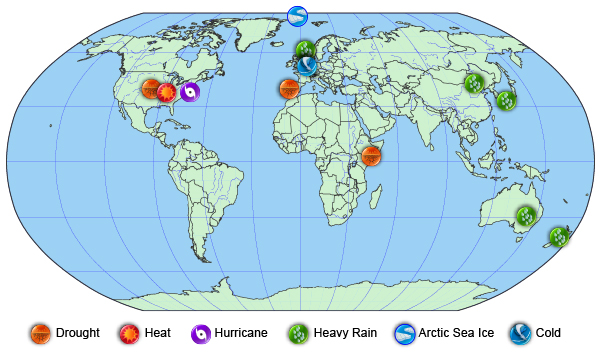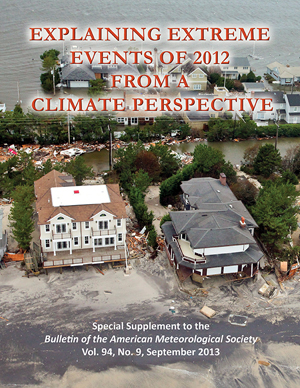Extreme Weather In 2012 Directly Linked To Climate Crisis
By Countercurrents.org
07 September, 2013
Countercurrents.org

Location and type of events analyzed in the Paper (pic: NOAA)
New analyses find evidence of human-caused climate crisis in half of the 12 extreme weather and climate events analyzed from 2012. *
This finding is a significant change in current assumptions on climate science. Scientists have so far been reluctant to attribute one particular weather event to global warming, but through improved modelling they are now able to confidently quantify the likelihood of climate crisis causing the event.
The "Explaining Extreme Events of 2012 from a Climate Perspective" report
Human influences are having an impact on some extreme weather and climate events, says the report “Explaining Extreme Events of 2012 from a Climate Perspective” released on September 5, 2013 by the Bulletin of the American Meteorological Society.
The report shows that the effects of natural weather and climate fluctuations played a key role in the intensity and evolution of the 2012 extreme events.
In some events, the analyses revealed compelling evidence that human-caused climate change, through the emission of heat-trapping gases, also contributed to the extreme event.
The models looked at various factors, including moisture in the air, atmospheric flow, and sea temperature and level.
Overall, 18 different research teams from around the world contributed to the peer-reviewed report that examined the causes of 12 extreme events that occurred on five continents and in the Arctic during 2012. Scientists from NOAA served as three of the four lead editors on the report.
The report is edited by Peterson, along with Martin P. Hoerling, NOAA's Earth System Research Laboratory; Peter A. Stott, UK Met Office Hadley Centre and Stephanie C. Herring of NCDC and written by 78 scientists from 11 countries.
“This report adds to a growing ability of climate science to untangle the complexities of understanding natural and human-induced factors contributing to specific extreme weather and climate events,” said Thomas R. Karl, L.H.D, director of NOAA's National Climatic Data Center (NCDC). “Nonetheless, determining the causes of extreme events remains challenging.”
In addition to investigating the causes of these extreme events, the multiple analyses of four of the events — the warm temperatures in the US, the record-low levels of Arctic sea ice, and the heavy rain in both northern Europe and eastern Australia — allowed the scientists to compare and contrast the strengths and weaknesses of their methods of analysis. Despite their different strategies, there was considerable agreement between the assessments of the same events.
Thomas Peterson, Ph.D., principal scientist at NOAA's NCDC and one of the lead editors on the report, said, “Scientists around the world assessed a wide variety of potential contributing factors to these major extreme events that, in many cases, had large impacts on society. Understanding the range of influences on extreme events helps us to better understand how and why extremes are changing."
Key findings include: Heat Wave and Drought in US
Human-induced climate change had little impact on the lack of precipitation in the central United States in 2012.
The 2012 spring and summer heat waves in the US can be mainly explained by natural atmospheric dynamics, however, human-induced climate change was found to be a factor in the magnitude of warmth and was found to have affected the likelihood of such heat waves. For example:
High temperatures, such as those experienced in the U.S. in 2012 are now likely to occur four times as frequently due to human-induced climate change.
Approximately 35 percent of the extreme warmth experienced in the eastern U.S. between March and May 2012 can be attributed to human-induced climate change.
Hurricane Sandy Inundation Probability
The record-setting impacts of Sandy were largely attributable to the massive storm surge and resulting inundation from the onshore-directed storm path coincident with high tide. However, climate-change related increases in sea level have nearly doubled today's annual probability of a Sandy-level flood recurrence as compared to 1950. Ongoing natural and human-induced forcing of sea level ensures that Sandy-level inundation events will occur more frequently in the future from storms with less intensity and lower storm surge than Sandy .
Arctic Sea Ice
The extremely low Arctic sea ice extent in summer 2012 resulted primarily from the melting of younger, thin ice from a warmed atmosphere and ocean. This event cannot be explained by natural variability alone. Summer Arctic sea ice extent will continue to decrease in the future, and is expected to be largely absent by mid-century.
Global Rainfall Events
The unusually high amount of summer rainfall in the United Kingdom in 2012 was largely the result of natural variability. However, there is evidence that rainfall totals are influenced by increases in sea surface temperature and atmospheric moisture which may be linked to human influences on climate.
The magnitude of the extreme rainfall experienced over southeastern Australia between October 2011 and March 2012 was mainly associated with La Niña conditions. However, the likelihood of above-average precipitation during March was found to have increased by 5 percent to 15 percent because of human influences on the climate.
Extreme rainfall events such as the December 2011 two-day rainfall in Golden Bay , New Zealand , are more likely to occur due to a 1 percent to 5 percent increase in available moisture resulting from increased levels of greenhouse gases in the atmosphere.
The July 2012 extreme rainfall events in North China and southwestern Japan were mainly due to natural variability.
However, weather incidents including the droughts across the US, eastern Kenya and Somalia, floods in northern China and heavy rain in southwestern Japan could not be directly attributed to global warming trends, and probably reflect natural variability in the weather.
* US Gov., Department of Commerce, National Oceanic and Atmospheric Administration, http://www.noaanews.noaa.gov/stories2013/20130905-extremeweatherandclimateevents.html
Comments are moderated


